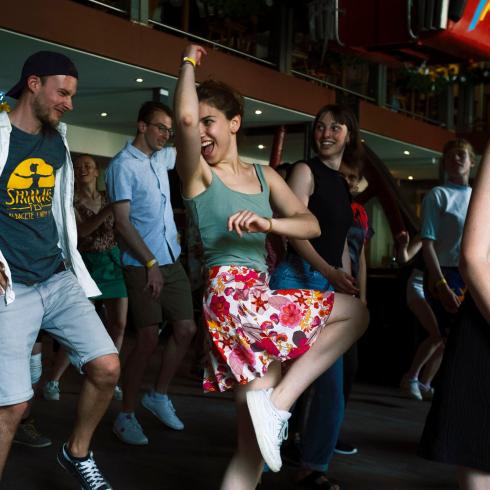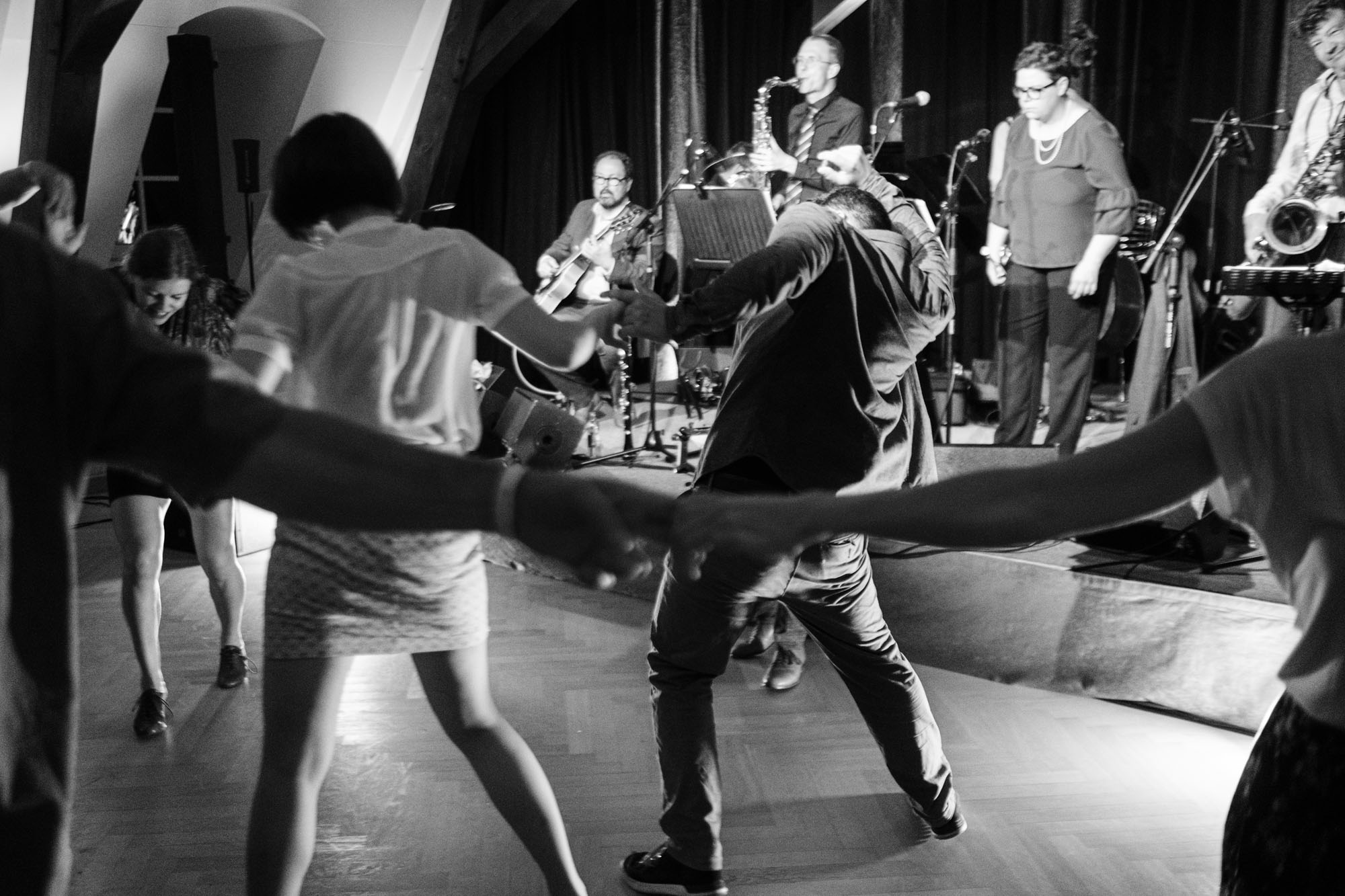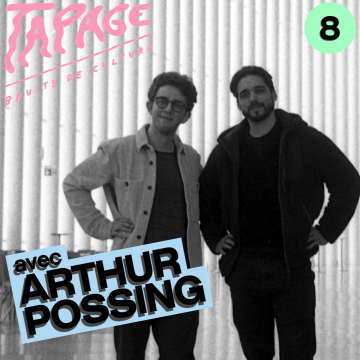11 mai. 20236th Edition Quattropole Swing Exchange

“Et ass en Danz, an deem een d’Liewensfreed erkennt, wou een sech net seriö hëlt a wou och jidderee ka matmaachen.”
For Anton Stepine, Swing is pure joy in motion. It is also the coming together of all sorts of people from different backgrounds sharing a passion for Swing music and dance. Helena Niemeijer highlights the fun factor, which, as she says, stems from the immense freedom, openness and playfulness that are at the heart of Swing.
Anton and Helena are both teachers at Swing Dance Luxembourg a.s.b.l., an association promoting Swing dance in Luxembourg since 2008, and co-organizers of the 6th Quattropole Swing Exchange, an international festival that takes place from 12th to 14th May 2023 in Metz/Luxembourg and from 19th to 21st May 2023 in Trier/Saarbrücken.
The origins of Swing
Swing music originated within the Afro-American community on the East Coast of the United States in the 1920s and 1930s. It’s a style of jazz that combined European music traditions with propulsive rhythms that displaced slaves brought with them from Africa. This mixture created a sort of swinging quality that gave the music its name and made it very danceable. As such, it was a short way from foot tapping to developing a whole range of dances around this new kind of music. That’s how Swing dance came along. Its origins can be traced back to the Savoy Ballroom, a dance club in Harlem, New York, where people of all colours danced together to the swinging jazz sounds of Big Bands, at the time a whole new type of musical ensemble consisting of trumpets, saxophones, trombones and a rhythm section. The fast-paced and partly acrobatic dance matched the energy and playfulness of the music and gave birth to the Swing era.
Although Swing flowed into other music genres and dances later on, it experienced a harsh decline in popularity after WWII. It was not until the 1980s that some people rediscovered recordings of these dances in old Hollywood movies and got enthralled by the vivid dance action at display. They went on to search for the dancers from these recordings and found them. Former Swing dance legends like Frankie Manning had returned to regular jobs after the Swing era ended and had already reached old age at that moment in time. Nonetheless, the Swing had not yet left their muscle memory, and they were keen to teach. Thus, they brought up a whole new generation of Swing dancers.
Since then, and especially in the last two decades, we have observed a huge boom in popularity. Swing dance schools and clubs popped up in every major city across Europe, and around those, sub-cultures emerged that revived and promoted these dances from the old days.
Swing in Luxembourg and beyond
Everybody dances with everybody, says Anton. There is no difference in age, skill or sex keeping you from asking somebody for a dance. This openness Anton traces back to the roots of Swing dance in the Savoy Ballroom, where not only black people danced with white people, but also women with women, and men with men. It was this liberal attitude that accompanied Swing throughout its history and makes it so appealing to so many different people.
Swing differs from other more classical dances, especially because it’s less structured and very free. According to Anton, it’s a precursor of modern street dances like hip hop, and as such, it’s usually not taught in dance schools. It rather emerged and developed in social contexts, where it is taught still today, as Helena puts it. That’s why at Luxembourg Swing Dance a.s.b.l., they have no professional teachers but only passionate volunteers willing to teach fellow enthusiasts.
What makes the Swing scene in Luxembourg stand out from others is its multicultural aspect. Anton, who had lived in London for a long time and returned to Luxembourg a few years ago, found in the association an international community he cherishes a lot. There you find many expats, Luxembourgers, but also people from neighboring cities hopping over for a quick swing in the evening, he says.
Thus, the Swing community in Luxembourg is integrated into a broader network of Swing scenes in the greater region, which consists of communities in Trier, Saarbrücken, and Metz. Swing is building bridges across national borders, and it’s this idea that forms the basis of the Quattropole Swing Exchange.

The Quattropole Swing Exchange
One festival, three countries, four cities. The Quattropole Swing Exchange offers a unique experience by taking dancers from city to city over the course of two weekends. Having reached its 6th edition, this year the festival counts more than 260 participants, a clear sign of the huge success it has known since it first took place in 2016.
The event, which is sponsored by the QuattroPole e.V., a cross-border network of the four cities supporting projects of European integration in the greater region, is co-organized by the four Swing dance associations in the cities Luxembourg, Trier, Saarbrücken and Metz, each of whom prepared their own program of activities. Participants then move together from station to station and host each other in their respective cities. This, for Anton, is most representative of the welcoming mentality of the Swing dance community.
After all, it’s the coming together, the exchange, which for Helena and Anton is the core idea of the festival. We brunch together and hang out together, they say, then there are different activities planned during the day like learning the Quattropole Choreo 2023, and every evening there is a huge dance event, where live-music is played by Big Bands and people like to dress in a 20s or 30s fashion.
The registration is open to everyone, and everyone is welcome, be it for shaking a leg on the dance floor or enjoying a drink at the bar in Abtei Neimënster while listening to the swinging sounds of past times.
For more information about the event and the Swing dance associations in the greater region, visit the following websites:
Quattropole Swing Exchange: https://www.quattropole-swing.com/
Swing Dance Luxembourg: https://www.swingdance.lu/
Lindy Hop Circle Trier: https://lindyhopcircletrier.de/
Metz Swing: https://metzswing.com/
Lindy Hop Saarbrücken: https://www.lindyhopsaarbruecken.de/
QuattroPole e.V.: https://quattropole.org/en
Les plus populaires
- 26 juin. 2024
- 28 juin. 2024
- 05 juil. 2024
- 04 juil. 2024
ARTICLES
Videos
26 juil. 2024TAPAGE avec Ruth Lorang
Articles
22 juil. 2024Le fabuleux destin de Raphael Tanios
Videos
19 juil. 2024

